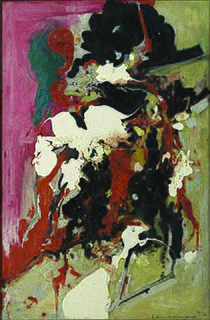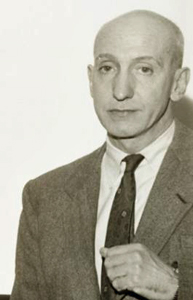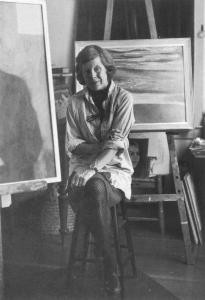Related Research Articles

Hans Hofmann was a German-born American painter, renowned as both an artist and teacher. His career spanned two generations and two continents, and is considered to have both preceded and influenced Abstract Expressionism. Born and educated near Munich, he was active in the early twentieth-century European avant-garde and brought a deep understanding and synthesis of Symbolism, Neo-impressionism, Fauvism, and Cubism when he emigrated to the United States in 1932. Hofmann's painting is characterized by its rigorous concern with pictorial structure and unity, spatial illusionism, and use of bold color for expressive means. The influential critic Clement Greenberg considered Hofmann's first New York solo show at Peggy Guggenheim’s Art of This Century in 1944 as a breakthrough in painterly versus geometric abstraction that heralded abstract expressionism. In the decade that followed, Hofmann's recognition grew through numerous exhibitions, notably at the Kootz Gallery, culminating in major retrospectives at the Whitney Museum of American Art (1957) and Museum of Modern Art (1963), which traveled to venues throughout the United States, South America, and Europe. His works are in the permanent collections of major museums around the world, including the Metropolitan Museum of Art, Tate Modern, Germanisches Nationalmuseum, National Gallery of Art, and Art Institute of Chicago.

Charles Webster Hawthorne was an American portrait and genre painter and a noted teacher who founded the Cape Cod School of Art in 1899.

Alma Woodsey Thomas was an African-American artist and teacher who lived and worked in Washington, D.C., and is now recognized as a major American painter of the 20th century. Thomas is best known for the "exuberant", colorful, abstract paintings that she created after her retirement from a 35-year career teaching art at Washington's Shaw Junior High School.
Edward Avedisian was an American abstract painter who came into prominence during the 1960s. His work was initially associated with Color field painting and in the late 1960s with Lyrical Abstraction.

The Provincetown Art Association and Museum (PAAM) is located at 460 Commercial Street in Provincetown, Massachusetts. It is accredited by the American Alliance of Museums and is the most attended art museum on Cape Cod. The museum's permanent collection includes over 2,500 objects, a number which continues to grow through donations and new acquisitions. PAAM mounts approximately forty exhibitions each year.

Perle Fine (1905–1988) was an American Abstract expressionist painter. Fine was most known by her combination of fluid and brushy rendering of the materials and her use of biomorphic forms encased and intertwined with irregular geometric shapes.
Deborah Martin is a contemporary American painter. Her artistic work examines the complexities of individual experience particularly in its relation to home, isolation and memory. Much of her practice emerges in collaborative conversation with writers and poets, taking form through exhibitions and publications. Her stark landscape paintings often convey the essence inherent within marginalized communities that exist on the fringes of American society. In 2016, Martin turned her focus to portraiture developing a long term project "Portraits of Autism" exploring the relationship and impact autistic children have within their immediate family and community on a continuum.
Nanno de Groot was a self-taught artist. He belonged to the group of New York School Abstract expressionist artists of the 1950s. He wrote:
In moments of clarity of thought I can sustain the idea that everything on earth is nature, including that which springs forth from a man's mind, and hand. A Franz Kline is nature as much as a zinnia.

Karl Knaths was an American artist whose personal approach to the Cubist aesthetic led him to create paintings which, while abstract, contained readily identifiable subjects. In addition to the Cubist painters, his work shows influence by Paul Cézanne, Wassily Kandinsky, Utagawa Kuniyoshi, Paul Klee, Stuart Davis, and Agnes Weinrich. It is nonetheless, in use of heavy line, rendering of depth, disciplined treatment of color, and architecture of planes, distinctly his own.

George McNeil was an American abstract expressionist painter.

Agnes Weinrich (1873–1946) was one of the first American artists to make works of art that were modernist, abstract, and influenced by the Cubist style. She was also an energetic and effective proponent of modernist art in America, joining with like-minded others to promote experimentation as an alternative to the generally conservative art of their time.

Betty Lane was an American artist.

Theresa Pollak was an American artist and art educator born in Richmond, Virginia. She was a nationally known painter, and she is largely credited with the founding of Virginia Commonwealth University's School of the Arts. She was a teacher at VCU's School of the Arts between 1928 and 1969. Her art has been exhibited in the Whitney Museum of American Art in New York, the Boston Museum of Fine Art, and the Corcoran Gallery in Washington, D.C. She died at the age of 103 on September 18, 2002 and was given a memorial exhibition at Anderson Gallery of Virginia Commonwealth University.
Walter Percy Chrysler Jr. was an American art collector, museum benefactor, and collector of other objects such as stamps, rare books, and glassworks. He was also a theatre and film producer.

Lily Harmon was an American visual artist. She studied at the Yale School of Fine Arts in New Haven, and then went on to the Académie Colarossi in Paris, and lastly at the Art Students League of New York.
James Lechay was an American painter who described himself an "abstract impressionist".
William Freed (1902–1984) was an American artist known for his role as a member of the American Modernist vanguard of the 1930s, his innovation as a central figure in Abstract Expressionism, and for his colorful abstract paintings.

Harriet Christina Cany Peale (1799–1869) was an American landscape, portrait, and genre painter of the mid-nineteenth century. Although sometimes described as a copyist, a greater share of her oeuvre has been made public in recent years, allowing Cany Peale to earn recognition for her genre and landscape paintings. She has been located in contemporary scholarship as an artist of the Hudson River School.
Ada Gilmore was an American watercolorist and printmaker, one of the Provincetown Printers.

Sally Michel Avery was an artist and illustrator who created modernist paintings of abstracted figures, landscapes, and genre scenes capturing personal moments of every day life. She was the co-creator of the "Avery style", wife and collaborator of artist Milton Avery, and mother of artist March Avery. Throughout their lives, Michel and Avery shared their studio space together, painting side by side, critiquing each other's work, and developing a shared style which includes the use of abstracted subjects, expressionistic color fields, and harmonious but unusual colors juxtapositions. Michel's work is the collections of the Metropolitan Museum of Art, the National Gallery of Art, the Pennsylvania Academy of Fine Arts, the Wadsworth Atheneum, and the Israel Museum, among others.
References
- 1 2 "Lilliam Orlowsky". POBA. Retrieved 27 September 2017.
- ↑ "Lillian Orlowsky Obituary". New York Times. Retrieved 27 September 2017.
- ↑ "Lillian Orlowsky". ACME Fine Art. Retrieved 27 September 2017.
- ↑ "Oral history interview with Lillian Orlowsky". Smithsonian Archives of American Art.
- ↑ "Lillian Orlowsky". Metropolitan Museum of Art Collection. Retrieved 27 September 2017.
- ↑ "Artidtd in the Collection". PAAM. Retrieved 27 September 2017.
- ↑ "Lillian Orlowsky". Chrysler Museum of Art. Retrieved 27 September 2017.